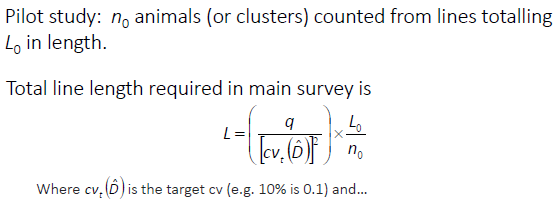Need help on best choice of survey design for primates study
Ambrose Bockarie Kanneh

A) The distance between one transects and the other is 500m and the length of each transect varies according to the shape of the study area (Island)

B) The transects have equal lengths of 400m each (400m is the smallest length that can fit for the narrowest part of the island and so I decided to maintain it), and the distance between transects are still 500m
The idea is to survey each transect once from the most appropriate design.
Thanks to whoever will come to my aid.
Kind regard,
Ambrose Bockarie Kanneh.
Eric Rexstad
Ambrose
Good to see you are making good progress designing your survey. From a statistical point of view, I think either design would be fine. Design A has 22 replicate transects (if I can count correctly); that is a sufficient number of replicate transects to assess encounter rate variance.
Design B has a greater number of
replicates at the expense of introducing more transit effort
between transects. I don't feel Design B is any better or worse
than Design A.
Does each survey have roughly the same amount of total transect length; I'm guessing the answer is yes, so nothing to suggest one over the other. Have you done a small pilot study, in which you can approximate the encounter rate for your focal species? If you have done a small study, you can use the formula below to estimate the total amount of transect length needed to produce a measure of precision (coefficient of variation) that you desire.


--
You received this message because you are subscribed to the Google Groups "distance-sampling" group.
To unsubscribe from this group and stop receiving emails from it, send an email to distance-sampl...@googlegroups.com.
To view this discussion on the web visit https://groups.google.com/d/msgid/distance-sampling/CADuW%3Dch0q14%3D2HAv9DxMVw2T9%3Dh3sE4Kwj9EbJiDLAsn7ccMkw%40mail.gmail.com.
-- Eric Rexstad Centre for Ecological and Environmental Modelling University of St Andrews St Andrews is a charity registered in Scotland SC013532
Ambrose Bockarie Kanneh
Eric Rexstad
Ambrose
Ask yourself what level of precision in
your abundance estimate would be necessary/useful in
understanding your species. You could then consider spending a
day or two walking several of the proposed transects, say 3-5km,
recording the total effort and the number of detections. Use
the information from that pilot survey in conjunction with the
formula provided earlier to assess what precision you might
expect from your proposed surveys of 30-40km of effort.
Stephen Buckland
I would tend to favour design A, as for narrow regions like this, there is a tendency to undersample near the edge of the region when using design B. However, I would not expect to see big differences, and practical considerations may dictate which of the two you use.
Steve Buckland
To view this discussion on the web visit https://groups.google.com/d/msgid/distance-sampling/CADuW%3Dcjfv17wxp3ofnP0j5QstEL-bLfwG3_7_scOsQJL66rj8w%40mail.gmail.com.
